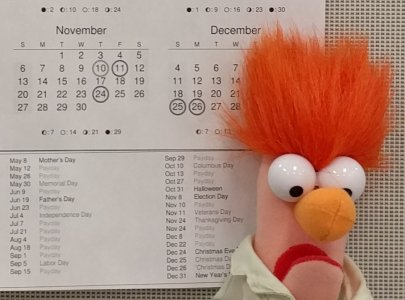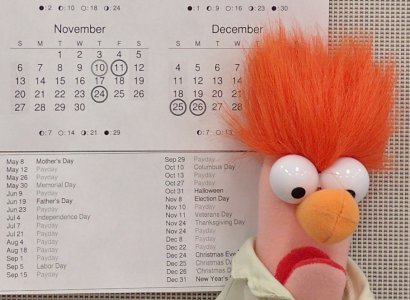- Nov 21, 2012
- 6,223
- 0
- 0
Hello my Pixel-infused peeps.... while I sit here with my 6P and look on with a wee bit of envy, I thought I'd pass along some info to you... specific to the Pixel's camera and how it manages to slay dragons, conquer the world and look so good doing it.
It's all about HDR+, a mode that I think is the single best feature of any phone/camera on the market. If you've seen me over in the 6P forum, you maybe would have seen my posts on the subject ( http://forums.androidcentral.com/nexus-6p/664172-explaining-hdr-why-s-worth-wait.html )
But I wanted to give you some more insight... I've enlisted my little friend here to show you why I love it so.
Here is are 100 crop shots... I know you might be distracted by the sexy beast in the picture...
Standard 100 crop (original 1/60s, ISO170)

HDR+ 100 crop (original 1/104s, ISO284)

Now, both pictures where taken at the same time/location/etc... Some things I want to point out....
Notice the settings for the camera. The HDR+ shot was taken with a faster shutter speed and a higher ISO (light sensitivity) setting. Normally, this would lead to doom in a picture as you would end up with a noisy and underexposed image. But HDR+ don't care about that... because it's going to take a bunch of those noisier, less exposed shots (I believe it's 5 in HDR Auto)) and do its thang. It will then combine those RAW image exposures, apply some optical magic borrowed from those nerds that like to stare at the night sky all the time, and spit out something full of win.
- Now, pay attention to the details. Details are where HDR+ makes its bones. On the standard image, like other phones, the camera relies on more conventional processing that tries to guess what to do to clean up noise and sharpen things up. Problem is that a computer program isn't always the best authority. Because HDR+ uses information from multiple, identical exposures (it doesn't play around with exposure bracketing or tonal mapping), it can make pixel by pixel decisions without sacrificing the original information. So Beaker's hair retains its fine, lustrous body... even individual whisps are retained and not scrubbed away or turned into a blocky artifact-heavy mess. Also look at the text, specifically on the gray text... traditional techniques would not be kind... And if you look at the lights reflected in Beaker's eyes, you can even make out the partition between the two bulbs. HDR+ makes every pixel count.
Now, of alllll the things said about the Pixel, the single biggest thing that caught my eye was that the improvements in speed and architecture allow the Pixel to be continuously taking pictures the entire time it is open, so taking an HDR+ (when in HDR+ Auto* ) requires none of the exposure delay that you saw on the 6P. That eliminates most all of the reasons to drop out of the mode to take a picture. Granted, on my 6P, I rarely switch off HDR Auto... but if you asked me if I would like to eliminate the exposure delay, I certainly wouldn't say no.
So enjoy the technical wizardry of your new phone!
* 'auto' mode for HDR+ uses fewer exposures and lighter processing than HDR On mode, so it is instant. HDR+ On, which does have a slight exposure delay, bumps the number of exposures to (7?) and also processes the dynamic range and colors more, resulting in a more traditional HDR look to the final shot)
It's all about HDR+, a mode that I think is the single best feature of any phone/camera on the market. If you've seen me over in the 6P forum, you maybe would have seen my posts on the subject ( http://forums.androidcentral.com/nexus-6p/664172-explaining-hdr-why-s-worth-wait.html )
But I wanted to give you some more insight... I've enlisted my little friend here to show you why I love it so.
Here is are 100 crop shots... I know you might be distracted by the sexy beast in the picture...
Standard 100 crop (original 1/60s, ISO170)

HDR+ 100 crop (original 1/104s, ISO284)

Now, both pictures where taken at the same time/location/etc... Some things I want to point out....
Notice the settings for the camera. The HDR+ shot was taken with a faster shutter speed and a higher ISO (light sensitivity) setting. Normally, this would lead to doom in a picture as you would end up with a noisy and underexposed image. But HDR+ don't care about that... because it's going to take a bunch of those noisier, less exposed shots (I believe it's 5 in HDR Auto)) and do its thang. It will then combine those RAW image exposures, apply some optical magic borrowed from those nerds that like to stare at the night sky all the time, and spit out something full of win.
- Now, pay attention to the details. Details are where HDR+ makes its bones. On the standard image, like other phones, the camera relies on more conventional processing that tries to guess what to do to clean up noise and sharpen things up. Problem is that a computer program isn't always the best authority. Because HDR+ uses information from multiple, identical exposures (it doesn't play around with exposure bracketing or tonal mapping), it can make pixel by pixel decisions without sacrificing the original information. So Beaker's hair retains its fine, lustrous body... even individual whisps are retained and not scrubbed away or turned into a blocky artifact-heavy mess. Also look at the text, specifically on the gray text... traditional techniques would not be kind... And if you look at the lights reflected in Beaker's eyes, you can even make out the partition between the two bulbs. HDR+ makes every pixel count.
Now, of alllll the things said about the Pixel, the single biggest thing that caught my eye was that the improvements in speed and architecture allow the Pixel to be continuously taking pictures the entire time it is open, so taking an HDR+ (when in HDR+ Auto* ) requires none of the exposure delay that you saw on the 6P. That eliminates most all of the reasons to drop out of the mode to take a picture. Granted, on my 6P, I rarely switch off HDR Auto... but if you asked me if I would like to eliminate the exposure delay, I certainly wouldn't say no.
So enjoy the technical wizardry of your new phone!
* 'auto' mode for HDR+ uses fewer exposures and lighter processing than HDR On mode, so it is instant. HDR+ On, which does have a slight exposure delay, bumps the number of exposures to (7?) and also processes the dynamic range and colors more, resulting in a more traditional HDR look to the final shot)
Last edited:





